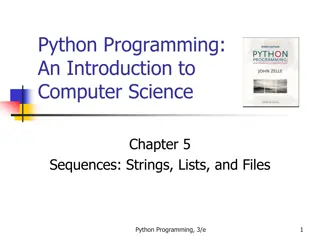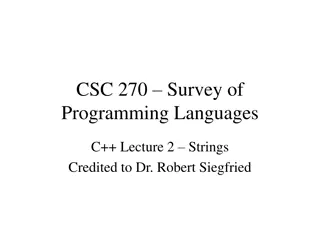Introduction to Python Strings and Basic Operations
Python Programming introduces the string data type, representing text in programs as a sequence of characters enclosed in quotation marks. This chapter covers operations on strings using built-in functions and methods, sequences and indexing in Python strings and lists, string formatting, cryptography basics, and processing textual information. Examples demonstrate creating and manipulating strings, accessing individual characters through indexing, and getting user input. Understanding strings is essential for text processing and manipulation in Python.
Download Presentation

Please find below an Image/Link to download the presentation.
The content on the website is provided AS IS for your information and personal use only. It may not be sold, licensed, or shared on other websites without obtaining consent from the author.If you encounter any issues during the download, it is possible that the publisher has removed the file from their server.
You are allowed to download the files provided on this website for personal or commercial use, subject to the condition that they are used lawfully. All files are the property of their respective owners.
The content on the website is provided AS IS for your information and personal use only. It may not be sold, licensed, or shared on other websites without obtaining consent from the author.
E N D
Presentation Transcript
Python Programming: An Introduction to Computer Science Chapter 8 Strings Python Programming, 4/e
Objectives To understand the string data type and how strings are represented in the computer. To become familiar with various operations that can be performed on strings through built-in functions and string methods. Python Programming, 4/e
Objectives To understand the basic idea of sequences and indexing as they apply to Python strings and lists. To be able to apply string formatting to produce attractive, informative program output. To understand basic concepts of cryptography. To be able to understand and write programs that process textual information. Python Programming, 4/e
The String Data Type The most common use of personal computers is word processing. Text is represented in programs by the string data type. A string is a sequence of characters enclosed within quotation marks (") or apostrophes ('). Python Programming, 4/e
The String Data Type >>> str1="Hello" >>> str2='spam' >>> print(str1, str2) Hello spam >>> type(str1) <class 'str'> >>> type(str2) <class 'str'> Python Programming, 4/e
The String Data Type Getting a string as input >>> firstName = input("Please enter your name: ") Please enter your name: John >>> print("Hello", firstName) Hello John Notice how we saved the user s name with a variable to print the name back out again. Python Programming, 4/e
The String Data Type We can access the individual characters in a string through indexing. The positions in a string are numbered from the left, starting with 0. The general form is <string>[<expr>], where the value of expr determines which character is selected from the string. Python Programming, 4/e 7
The String Data Type H e l l o B o b 0 1 2 3 4 5 6 7 8 >>> greet = "Hello Bob" >>> greet[0] 'H' >>> print(greet[0], greet[2], greet[4]) H l o >>> x = 8 >>> print(greet[x - 2]) B The Python shell shows us the value of strings by putting them in single quotes; when we print the string, Python does not put any quotes around the sequence of characters. Python Programming, 4/e 8
The String Data Type H e l l o B o b 0 1 2 3 4 5 6 7 8 In a string of n characters, the last character is at position n-1 since we start counting with 0. We can index from the right side using negative indexes. >>> greet[-1] 'b' >>> greet[-3] 'B' Python Programming, 4/e 9
The String Data Type Indexing returns a string containing a single character from a larger string. We can also access a contiguous sequence of characters, called a substring, through a process called slicing. Python Programming, 4/e 10
The String Data Type Slicing: <string>[<start>:<end>] start and end should both be ints The slice contains the substring beginning at position start and runs up to but doesn t include the position end. Python Programming, 4/e 11
The String Data Type H e l l o B o b 0 1 2 3 4 5 6 7 8 >>> greet[0:3] 'Hel' >>> greet[5:9] ' Bob' >>> greet[:5] 'Hello' >>> greet[5:] ' Bob' >>> greet[:] 'Hello Bob' Python Programming, 4/e 12
The String Data Type If either expression is missing, then the start or the end of the string are used. Can we put two strings together into a longer string? Concatenation glues two strings together (+) Repetition builds up a string by multiple concatenations of a string with itself (*) Python Programming, 4/e 13
The String Data Type The function len will return the length of a string. >>> "spam" + "eggs" 'spameggs' >>> "Spam" + "And" + "Eggs" 'SpamAndEggs' >>> 3 * "spam" 'spamspamspam' >>> "spam" * 5 'spamspamspamspamspam' >>> (3 * "spam") + ("eggs" * 5) 'spamspamspameggseggseggseggseggs' Python Programming, 4/e 14
The String Data Type >>> len("spam") 4 >>> for ch in "Spam!": print (ch, end=" ") S p a m ! Python Programming, 4/e 15
The String Data Type Operator + * <string>[] <string>[:] len(<string>) for <var> in <string> Meaning Concatenation Repetition Indexing Slicing Length Iteration through characters Python Programming, 4/e 16
Simple String Processing Usernames on a computer system First initial, first seven characters of last name # get user s first and last names first = input("Please enter your first name (all lowercase): ") last = input("Please enter your last name (all lowercase): ") # concatenate first initial with 7 chars of last name uname = first[0] + last[:7] Python Programming, 4/e 17
Simple String Processing >>> Please enter your first name (all lowercase): john Please enter your last name (all lowercase): doe uname = jdoe >>> Please enter your first name (all lowercase): donna Please enter your last name (all lowercase): rostenkowski uname = drostenk Python Programming, 4/e 18
Simple String Processing Another use converting an int that stands for the month into the three letter abbreviation for that month. Store all the names in one big string: JanFebMarAprMayJunJulAugSepOctNovDec Use the month number as an index for slicing this string: monthAbbrev = months[pos:pos+3] Python Programming, 4/e 19
Simple String Processing Month Number Position Jan 1 0 Feb 2 3 Mar 3 6 Apr 4 9 To get the correct position, subtract one from the month number and multiply by three Python Programming, 4/e 20
Simple String Processing # month.py # A program to print the abbreviation of a month, given its number def main(): # months is used as a lookup table months = "JanFebMarAprMayJunJulAugSepOctNovDec" n = int(input("Enter a month number (1-12): ")) # compute starting position of month n in months pos = (n-1) * 3 # Grab the appropriate slice from months monthAbbrev = months[pos:pos+3] # print the result print ("The month abbreviation is", monthAbbrev + ".") Python Programming, 4/e 21
Simple String Processing >>> main() Enter a month number (1-12): 1 The month abbreviation is Jan. >>> main() Enter a month number (1-12): 12 The month abbreviation is Dec. One weakness this method only works where the potential outputs all have the same length. How could you handle spelling out the months? Python Programming, 4/e 22
String Representation Inside the computer, strings are represented as sequences of 1 s and 0 s, just like numbers. A string is stored as a sequence of binary numbers, one number per character. It doesn t matter what value is assigned as long as it s done consistently. Python Programming, 4/e 23
String Representation In the early days of computers, each manufacturer used their own encoding of numbers for characters. ASCII system (American Standard Code for Information Interchange) uses numbers between 0 and 127. Python supports Unicode (100,000+ characters) Python Programming, 4/e 24
String Representation The ord function returns the numeric (ordinal) code of a single character. The chr function converts a numeric code to the corresponding character. >>> ord("A") 65 >>> ord("a") 97 >>> chr(97) 'a' >>> chr(65) 'A' Python Programming, 4/e 25
String Representation The smallest addressable memory unit is generally 8 bits, called a byte. 8 bits can be used to encode up to 256 values, more than enough for ASCII. Unicode is different in that it uses various encoding schemes to pack Unicode characters into sequences of bytes. The most common encoding used for this is called UTF-8. UTF-8 uses between one (for Latin alphabets) and four bytes for some of the more exotic characters.
Programming an Encoder Using ord and char we can convert a string into and out of numeric form. The encoding algorithm is simple: get the message to encode for each character in the message: print the letter number of the character A for loop iterates over a sequence of objects, so the for loop looks like: for ch in <string> Python Programming, 4/e 27
Programming an Encoder # text2numbers.py # A program to convert a textual message into a sequence of # numbers, utlilizing the underlying Unicode encoding. def main(): print("This program converts a textual message into a sequence") print ("of numbers representing the Unicode encoding of the message.\n") # Get the message to encode message = input("Please enter the message to encode: ") print("\nHere are the Unicode codes:") # Loop through the message and print out the Unicode values for ch in message: print(ord(ch), end=" ") print() # blank line before prompt Python Programming, 4/e 28
Programming a Decoder We now have a program to convert messages into a type of code , but it would be nice to have a program that could decode the message! The outline for a decoder: get the sequence of numbers to decode message = "" for each number in the input: convert the number to the appropriate character add the character to the end of the message print message Python Programming, 4/e 29
Programming a Decoder The variable message is an accumulator variable, initially set to the empty string, the string with no characters (""). Each time through the loop, a number from the input is converted to the appropriate character and appended to the end of the accumulator. Python Programming, 4/e 30
Programming a Decoder How do we get the sequence of numbers to decode? We don t know how many numbers there will be! Read the input as a single string, then split it apart into substrings, each of which represents one number. Iterate through the list of smaller strings, convert each into a number and use that number to produce the corresponding Unicode character. Python Programming, 4/e 31
Programming a Decoder The new algorithm get the sequence of numbers as a string, inString split inString into a sequence of smaller strings message = "" for each of the smaller strings: change the string of digits into the number it represents append the Unicode character for that number to message print message Python Programming, 4/e 32
Programming a Decoder Strings are objects and have useful methods associated with them One of these methods is split. This will split a string into substrings based on spaces. >>> "Hello string methods!".split() ['Hello', 'string', 'methods!'] Python Programming, 4/e 33
Programming a Decoder Split can be used on characters other than space, by supplying the character as a parameter. >>> "32,24,25,57".split(",") ['32', '24', '25', '57'] Python Programming, 4/e 34
Programming a Decoder # numbers2text.py # A program to convert a sequence of Unicode numbers into # a string of text. def main(): print ("This program converts a sequence of Unicode numbers into") print ("the string of text that it represents.\n") # Get the message to encode inString = input("Please enter the Unicode-encoded message: ") # Loop through each substring and build Unicde message message = "" for numStr in inString.split(): # convert the (sub)string to a number codeNum = int(numStr) # append character to message message = message + chr(codeNum) print("\nThe decoded message is:", message) Python Programming, 4/e 35
Programming a Decoder The split function produces a list of substrings. numString gets each successive substring. Each time through the loop, the next substring is converted to the appropriate Unicode character and appended to the end of the accumulator, message. Python Programming, 4/e 36
Programming a Decoder ------------------------------------------------------------------------- This program converts a textual message into a sequence of numbers representing the Unicode encoding of the message. Please enter the message to encode: CS120 is fun! Here are the Unicode codes: 67 83 49 50 48 32 105 115 32 102 117 110 33 -------------------------------------------------------------------------- This program converts a sequence of Unicode numbers into the string of text that it represents. Please enter the ASCII-encoded message: 67 83 49 50 48 32 105 115 32 102 117 110 33 The decoded message is: CS120 is fun! Python Programming, 4/e 37
From Encoding to Encryption The process of encoding information for the purpose of keeping it secret or transmitting it privately is called encryption. Cryptography is the study of encryption methods. Encryption is used when transmitting credit card and other personal information to a web site. Python Programming, 4/e 38
From Encoding to Encryption Strings are represented as a sort of encoding problem, where each character in the string is represented as a number that s stored in the computer. The code that is the mapping between character and number is an industry standard, so it s not secret . Python Programming, 4/e 39
From Encoding to Encryption The encoding/decoding programs we wrote use a substitution cipher, where each character of the original message, known as the plaintext, is replaced by a corresponding symbol in the cipher alphabet. The resulting code is known as the ciphertext. Python Programming, 4/e 40
From Encoding to Encryption This type of code is relatively easy to break. Each letter is always encoded with the same symbol, so using statistical analysis on the frequency of the letters and trial and error, the original message can be determined. Python Programming, 4/e 41
From Encoding to Encryption Modern encryption converts messages into numbers. Sophisticated mathematical formulas convert these numbers into new numbers usually this transformation consists of combining the message with another value called the key Python Programming, 4/e 42
From Encoding to Encryption To decrypt the message, the receiving end needs an appropriate key so the encoding can be reversed. In a private key (or shared key) system the same key is used for encrypting and decrypting messages. Everyone you know would need a copy of this key to communicate with you, but it needs to be kept a secret. Python Programming, 3/e 43
From Encoding to Encryption In public key encryption, there are separate keys for encrypting and decrypting the message. In public key systems, the encryption key is made publicly available, while the decryption key is kept private. Anyone with the public key can send a message, but only the person who holds the private key (decryption key) can decrypt it. Python Programming, 3/e 44
More String Methods There are a number of other string methods. Try them all! s.capitalize() Copy of s with only the first character capitalized s.title() Copy of s; first character of each word capitalized s.center(width) Center s in a field of given width Python Programming, 4/e 45
More String Methods s.count(sub) Count the number of occurrences of sub in s s.find(sub) Find the first position where sub occurs in s s.join(list) Concatenate list of strings into one large string using s as separator. s.ljust(width) Like center, but s is left-justified Python Programming, 4/e 46
More String Methods s.lower() Copy of s in all lowercase letters s.lstrip() Copy of s with leading whitespace removed s.replace(oldsub, newsub) Replace occurrences of oldsub in s with newsub s.rfind(sub) Like find, but returns the right-most position s.rjust(width) Like center, but s is right-justified Python Programming, 4/e 47
More String Methods s.rstrip() Copy of s with trailing whitespace removed s.split() Split s into a list of substrings s.upper() Copy of s; all characters converted to uppercase Python Programming, 4/e 48
Python has a number of other standard More String Methods libraries for text processing consult the documentation to learn more! Programs that are primarily processing numeric information may need to use string expressions. Consider a program to do financial analysis that treats some inputs as strings, and after doing some number crunching, produces a nicely formatted report. Suppose we want to update the chaos program (from Chapter 1) to compare the Python Programming, 4/e 49
More String Methods This program illustrates a chaotic function. Enter two starting values between 0 and 1: .25 .26 Suppose we want to modify the Chapter 1 chaos program to produce output like the following: input: 0.25 0.26 --------------------------- 0.731250 0.750360 0.766441 0.730547 0.698135 0.767707 0.821896 0.695499 0.570894 0.825942 0.955399 0.560671 0.166187 0.960644 0.540418 0.147447 0.968629 0.490255 0.118509 0.974630 Python Programming, 4/e 50























